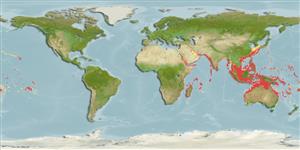Common names from other countries
Environment: milieu / climate zone / depth range / distribution range
Ecología
marino; salobre asociado a arrecife; rango de profundidad 2 - 178 m (Ref. 86942), usually 15 - 75 m (Ref. 9710). Tropical; 30°N - 35°S
Indo-Pacific: East Africa and Persian Gulf to the Society Islands, north to southern Japan, south to Lord Howe Island. Throughout Micronesia.
Tamaño / Peso / Age
Maturity: Lm ? range ? - ? cm
Max length : 25.0 cm TL macho / no sexado; (Ref. 5372); common length : 15.0 cm TL macho / no sexado; (Ref. 5450)
Espinas dorsales (total) : 11 - 12; Radios blandos dorsales (total) : 22 - 27; Espinas anales: 3; Radios blandos anales: 17 - 19.
Inhabit deep, protected lagoons and channels, and the deeper parts of outer reef slopes. Juveniles are often solitary while adults occur in pairs (Ref. 1602, 48636). A planktivorous species that generally remains within a few meters of the reef. Juveniles may sometimes pick on parasites on the epidermis of other fish (Ref. 5503). Oviparous (Ref. 205). Form pairs during breeding (Ref. 205).
Life cycle and mating behavior
Maturities | Reproducción | Spawnings | Egg(s) | Fecundities | Larva
Form pairs during breeding (Ref. 205).
Steene, R.C., 1978. Butterfly and angelfishes of the world. A.H. & A.W. Reed Pty Ltd., Australia. vol. 1. 144 p. (Ref. 4859)
IUCN Red List Status (Ref. 130435)
CITES (Ref. 128078)
Not Evaluated
Threat to humans
Harmless
Human uses
Pesquerías: escaso valor comercial; Acuicultura: comercial; Acuario: Comercial
Herramientas
Special reports
Download XML
Fuentes de Internet
Estimates based on models
Preferred temperature (Ref.
115969): 23.6 - 29.1, mean 27.9 (based on 2680 cells).
Phylogenetic diversity index (Ref.
82804): PD
50 = 0.5039 [Uniqueness, from 0.5 = low to 2.0 = high].
Bayesian length-weight: a=0.02291 (0.01452 - 0.03614), b=3.04 (2.90 - 3.18), in cm Total Length, based on LWR estimates for this species & (Sub)family-body (Ref.
93245).
Nivel trófico (Ref.
69278): 3.8 ±0.37 se; based on food items.
Resiliencia (Ref.
120179): Alto, población duplicada en un tiempo mínimo inferior a 15 meses (Preliminary K or Fecundity.).
Fishing Vulnerability (Ref.
59153): Low vulnerability (15 of 100).
